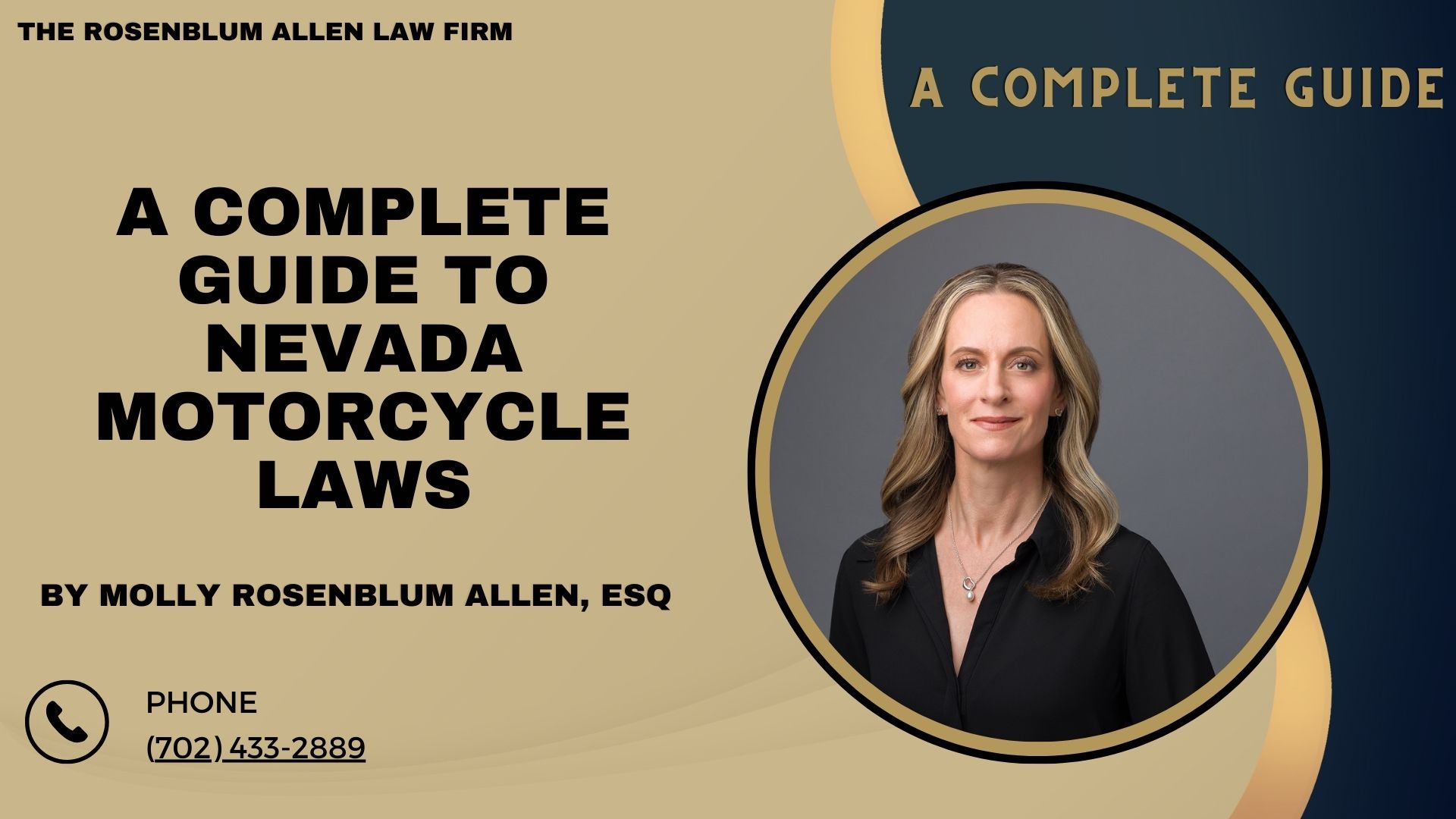Welcome to your go-to resource for understanding motorcycle laws in Nevada. Whether you’re an experienced rider or new to motorcycles, knowing the state’s rules is key. They are critical to a safe and fun ride. This guide covers everything from licensing to the required gear, so let’s get started.

Licensing Requirements
It would help to have the proper license or endorsement to ride a motorcycle in Nevada.
Obtaining a Motorcycle License in Nevada
You must have a Class M motorcycle license or endorsement to ride in Nevada. Here’s what you need to know:
Eligibility Criteria
Age: You need to be at least 16.
Instruction Permit: Riders under 18 should have an instruction permit for six months.
Education: Under 18s must finish a motorcycle safety course. It’s a good idea for everyone.
The Written and Skills Test Process
Written Test: This covers the basics of motorcycle operation, safety rules, and Nevada law.
Skills Test: You’ll show you can handle a motorcycle safely. If you’ve done a safety course, you might skip this.
Motorcycle Endorsements
Adding a motorcycle endorsement to your existing license is another option.
Process: It’s much like getting a motorcycle license, including the tests or safety course.
Why: It lets you drive cars and motorcycles without two separate licenses.

Equipment and Safety Gear
Safety is a big deal in Nevada, and there are rules about what gear you need.
Helmet Laws
All riders and passengers need helmets. The helmets must meet U.S. Department of Transportation standards.
Age Requirements and Safety Standards
Everyone: Helmets are a must, no matter your age.
Standards: DOT-certified helmets meet the safety requirements.
Eye Protection
Your eyes need protection, too, especially if your bike doesn’t have a windscreen.
Regulations on Goggles and Face Shields
Required: You need eye protection, like goggles, glasses, or a face shield that won’t shatter.
Reflective Clothing
It’s not required by law. But, reflective clothing makes you more visible to drivers.
Recommendations for Visibility
Any Time: Reflective gear can make a big difference in how well others see you.
Extra Tips: Putting reflective stickers on your helmet and bike also helps.
Riding in Nevada is an adventure; knowing the law keeps it safe and fun. This guide has started with licensing and gear. Stay with us as we explore how to operate a motorcycle. We’ll also cover insurance and other key topics. This will ensure you’re fully prepared.

Motorcycle Operation
Knowing how to legally and safely operate your motorcycle in Nevada is essential. Let’s review some important rules.
Lane Splitting and Sharing
Lane Splitting: This is when a motorcycle moves between lanes of slow or stopped cars. It’s not allowed in Nevada.
Passenger Rules
If you’re carrying a passenger, follow these guidelines:
Age and Equipment: Passengers must be able to reach the footrests. Your motorcycle should have a seat and footrests for them.
Signals and Lights
Make sure your motorcycle’s signals and lights work:
Turn Signals: If your bike has them, they must function.
Lights: You need working brake lights and a headlamp, which must be on day and night.
Insurance and Registration
To ride in Nevada, you must register your motorcycle and have insurance.
Minimum Insurance
It would help if you had at least this much insurance:
Liability: This covers harm you might cause to others. You need $25,000 for injury per person, $50,000 for injury per accident, and $20,000 for property damage.
Registering Your Motorcycle
Here’s how to register your bike:
What You Need: Bring proof of ownership, insurance, and, if required, an emissions test result.
Costs: You’ll pay a title fee and a registration fee. The amounts vary.

Riding Under the Influence
It’s dangerous and illegal to ride after drinking or using drugs.
DUI Rules
Nevada’s laws are strict:
Limit: The blood alcohol content limit is 0.08%.
Consequences: Expect fines, possible jail time, and license suspension if you break the law.
Avoid DUIs
The best advice is simple: Don’t drink and ride.

Safety and Training
Taking a motorcycle safety course is a great idea.
Motorcycle Safety Courses
These courses are beneficial for:
Skills: They teach or refresh your riding skills.
Insurance: Finishing a course may reduce your insurance rates.
Advanced Rider Training
For more experienced riders:
Benefits: Learn advanced techniques for safer, more efficient riding.
Who Should Take It: Any rider looking to improve.
Following these guidelines ensures you enjoy riding in Nevada safely and legally. Staying informed is key to a good ride. You need to know about operation laws, insurance, registration, and training. Remember these tips to ensure you’re always ready for the road ahead.

Annual Events and Rides
Nevada’s motorcycle scene buzzes with events and rides. Here’s how to dive in safely.
Joining Nevada Motorcycle Events
Find Events: Nevada has many motorcycle events, from charity rides to rallies.
Prepare: Check the event’s requirements before you go. You might need specific documents or gear.
What You Need for Events
Paperwork: Have your bike’s insurance and registration up to date.
Gear: Wear a helmet and eye protection. Reflective clothing is also a good idea.

Getting Help with Legal Issues
Facing legal issues can be challenging. Here’s how to handle them.
If You Get a Ticket
Understand the Issue: Know what the ticket is for and what it means.
Legal Advice: A traffic lawyer can help, especially if it’s complex.
After an Accident
What to do if there’s a crash:
At the Scene: Make sure everyone is safe, call for help, and swap details with the other driver.
Later: A lawyer can guide you through insurance or legal steps.

Breaking It All Down
Riding in Nevada offers endless adventures, from scenic routes to lively motorcycle culture. The key to enjoying these experiences is knowing the state’s motorcycle laws. You must follow them. You may be gearing up for an event, dealing with legal matters, or just enjoying the ride. Staying informed keeps you safe. Keep this guide close, and enjoy the road ahead with confidence.

Frequently Asked Questions
Do I have to wear a helmet on a motorcycle in Nevada, no matter my age?
Yes, Nevada requires all motorcycle riders to wear DOT-certified helmets. This rule applies to passengers as well, regardless of age.
Is it okay to lane split in Nevada when traffic is at a standstill?
No, Nevada law prohibits lane splitting under all conditions.
Are helmets required on private property or in parking lots in Nevada?
Yes, you must wear a motorcycle helmet, even on private property or parking lots.
Must my motorcycle have turn signals in Nevada?
Turn signals are not mandatory on all motorcycles, but they must work properly if your bike has them.
What should I do immediately after a motorcycle accident in Nevada?
Put safety first. Call emergency services if needed. Also, exchange contact and insurance info with others involved.
Can taking a motorcycle safety course lower my insurance rates in Nevada?
Taking a motorcycle safety course can lower insurance rates. It can also improve your riding skills.
Do Nevada’s motorcycle laws apply to visitors, too?
Yes, visitors must follow Nevada’s motorcycle laws. They include wearing helmets and having insurance.
How often do I need to renew my motorcycle’s registration in Nevada?
You need to renew your motorcycle registration every year.
Can I wear a non-DOT helmet while riding in Nevada?
No, only DOT-certified helmets are legal for riding in Nevada.
What’s the maximum legal blood alcohol concentration for riding a motorcycle in Nevada?
The legal limit is 0.08% BAC, the same as for driving cars.
Is wearing a reflective vest mandatory while riding a motorcycle in Nevada?
Reflective vests are not required. But, it’s recommended to wear them. They increase visibility.
Does my motorcycle passenger need their insurance in Nevada?
No, your motorcycle insurance should cover passengers. But, check your policy to be sure it includes passenger coverage.

Glossary
BAC (Blood Alcohol Content): The alcohol level in your blood. Nevada’s legal limit for riders is 0.08%.
DOT-Certified Helmet: A safety helmet approved by the U.S. Department of Transportation. It’s a must for riders and passengers in Nevada.
Lane Splitting: Moving your motorcycle between lanes of stopped or slow cars. It’s not allowed in Nevada.
Liability Insurance: This insurance covers costs if you cause an accident. Nevada requires it for all riders.
Motorcycle Endorsement: A unique addition to your driver’s license that allows you to ride motorcycles. In Nevada, you can get this or a Class M license.
Motorcycle Registration: The process to officially list your motorcycle with the state. It’s necessary for all motorcycles in Nevada.
Passenger Regulations: Rules for carrying passengers, like needing a proper seat and footrests.
Reflective Clothing: Clothes are made with materials that shine in the dark. They’re not mandatory in Nevada but recommended.
Safety Course: A class that teaches you how to ride safely. It can help lower insurance costs and is a good idea for new riders.
Signal and Lighting Requirements: Nevada law says your motorcycle must have a working headlamp and, if present, working turn signals.
Skills Test: A practical exam to show you can ride safely. You might skip it if you’ve taken a safety course.

Additional Resources for You
Our lead attorney, Molly Rosenblum Allen, Esq., has created several resources for those in need of legal assistance. Here’s a straightforward guide to what we offer:
- Hurt in an accident? Visit our Las Vegas Personal Injury Attorney page.
- Involved in a car crash? Check out Las Vegas Car Accident Attorney.
- For motorcycle accident concerns, see Motorcycle Accident Lawyer Las Vegas.
- If you’ve lost a loved one due to negligence, our Wrongful Death Lawyer Las Vegas can help.
- For truck accident issues, visit Truck Accident Attorney Las Vegas.
- Dealing with a drunk driving incident? Our Las Vegas Drunk Driving Accident Attorney is here.
- Slipped and fell? Go to Las Vegas Slip and Fall Attorney.
Molly Rosenblum Allen, Esq., offers these resources to ensure you have the right legal support when you need it. Each link leads to detailed information on how we can assist you.

Outside Resources for You
Here are seven straightforward resources you might find helpful:
American Bar Association (ABA): This is your go-to for legal guides and finding legal help. Visit ABA
National Highway Traffic Safety Administration (NHTSA): Find safety tips and data on road safety, focusing on motorcycles. Visit NHTSA
Insurance Information Institute (III): Learn about different insurance options, including motorcycle insurance. Visit III
National Association of Insurance Commissioners (NAIC): Understand insurance laws and find your state’s insurance requirements. Visit NAIC
American Motorcyclist Association (AMA): Offers information on motorcycle rights and legal advocacy. Visit AMA
FindLaw: A comprehensive site for legal information, including personal injury and traffic laws. Visit FindLaw
United States Department of Transportation (USDOT): Get info on transportation and safety laws affecting riders. Visit USDOT
These resources are great for exploring legal advice, insurance details, and safety guidelines related to motorcycle riding.

A Special Message from Our Lead Attorney, Molly Rosenblum Allen, Esq

Thanks for reading our guides. I’m Molly Rosenblum Allen, Esq. I hope you found the information helpful. We’re here for you if you have questions or need more help. You can schedule a free consultation by calling us at (702) 433-2889. Let’s talk about how we can assist you further.
Best,
Molly Rosenblum Allen, Esq.


